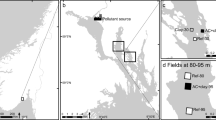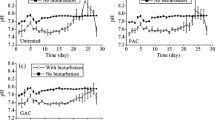Abstract
Ongoing inputs, in the form of sediment deposition along with associated dissolved contaminants, have challenged the assessment of cap performance at contaminated sediment sites. To address this issue, thin 2–3 cm layer sand caps amended with activated carbon (AC) were investigated for the remediation of polychlorinated biphenyl (PCB) contaminated marine sediments using 90-day mesocosms. All treatments were challenged with (1) ongoing clean or marker-PCB-spiked sediment inputs and (2) bioturbation. Bioaccumulation in hard clams (filter feeding near the cap-water interface) was evaluated to best understand cap effectiveness, relative to sheepshead minnows (confined to the surface water) and sandworms (which burrowed through the caps). All caps (sand and AC amended sand) provided isolation of native bedded PCBs (i.e., PCBs sourced from the bed), reducing uptake in organisms. Total PCB bioaccumulation in clams indicated that AC addition to the cap provided no benefit with spiked influx, or some benefit (56% reduction) with clean influx. Spiked input PCBs, when added to the depositional input sediment, were consistently detected in clams and passive samplers, with and without AC in the cap. PCB uptake by passive samplers located in the caps did not reflect the performance of the remedy, as defined by clam bioaccumulation. However, PCB uptake by passive samplers in the overlying water reasonably represented clam bioaccumulation results.




Similar content being viewed by others
References
Abel S, Akkanen J (2018) A combined field and laboratory study on activated carbon-based thin layer cap** in a PCB-contaminated boreal lake. Environ Sci Technol 52:4702–4710. https://doi.org/10.1021/acs.est.7b05114
Abel S, Nybom I, Akkanen J (2020) Carbon amendments and remediation of contaminated sediments. Bioavailab Organ Chem Soil Sedim 100:221–241. https://doi.org/10.1007/698_2020_512
Albarano L, Costantini M, Zupo V, Lofranco G, Guida M, Libralato G (2020) Marine sediment toxicity: a focus on micro- and mesocosms toward remediation. Sci Total Environ 708:134837. https://doi.org/10.1016/j.scitotenv.2019.134837
Booij K, Smedes F (2010) An improved method for estimating in situ sampling rates of nonpolar passive samplers. Environ Sci Technol 44:6789–6794. https://doi.org/10.1021/es101321v
Bosworth WS, Thibodeaux LJ (1990) Bioturbation: a facilitator of contaminant transport in bed sediment. Environ Prog 9(4):211–217. https://doi.org/10.1002/ep.670090414
Cho Y-M, Werner D, Choi Y, Luthy RG (2012) Long-term monitoring and modeling of the mass transfer of polychlorinated biphenyls in sediment following pilot-scale in-situ amendment with activated carbon. J Contam Hydrol 129–130:25–37. https://doi.org/10.1016/j.jconhyd.2011.09.009
Cornelissen G, Amstaetter K, Hauge A, Schaanning M, Beylich B, Gunnarsson JS, Breedveld GD, Oen AMP, Eek E (2012) Large-scale field study on thin-layer cap** of marine PCDD/F contaminated sediments in Grenlandfjords, Norway: physicochemical effects. Environ Sci Technol 46:12030–12037. https://doi.org/10.1021/es302431u
Cornelissen G, Schaanning M, Gunnarsson JS, Eek E (2015) A large-scale field trial of thin-layer cap** of PCDD/F-contaminated sediments: sediment-to-water fluxes up to 5 years post-amendment. Integr Environ Assess Manag 12(2):216–221. https://doi.org/10.1002/ieam.1665
Fetters K, Rosen G, Kirtay V, Chadwick B, Conder J, Sacks VP, Grover M, Magar V (2020) Demonstration and validation of enhanced monitored natural recovery at a pesticide-contaminated sediment site. J Soils Sedim 20:204–219. https://doi.org/10.1007/s11368-019-02386-4
Gidley PT, Kwon S, Yakirevich A, Magar VS, Ghosh U (2012) Advection dominated transport of polycyclic aromatic hydrocarbons in amended sediment caps. Environ Sci Technol 46(9):5032–5039. https://doi.org/10.1021/es202910c
Gidley PT, Kennedy AJ, Lotufo GR, Wooley AH, Melby NL, Ghosh U, Burgess RM, Mayer P, Fernandez LA, Schmidt SN, Wang AP, Bridges TS, Ruiz CE (2019) Bioaccumulation in functionally different species: ongoing input of PCBs with sediment deposition to activated carbon remediated bed sediments. Environ Toxicol Chem 38(10):2326–2336. https://doi.org/10.1002/etc.4526
Grizzle RE, Bricelj VM, Shumway SE (2001) Physiological ecology of Mercenaria mercenaria. In: Kraeuter JN, Castagna M (eds) Biology of the hard clam, 1st edn. Elsevier Science B.V, Amsterdam, pp 305–382. https://doi.org/10.1016/S0167-9309(01)80036-3
Josefsson S, Schaanning M, Samuelsson GS, Gunnarsson JS, Olofsson I, Eek E, Wilberg K (2012) Cap** efficiency of various carbonaceous and mineral materials for in situ remediation of polychlorinated dibenzo-p-dioxin and dibenzofuran contaminated marine sediments: sediment-to-water fluxes and bioaccumulation in boxcosm tests. Environ Sci Technol 46:3343–3351. https://doi.org/10.1021/es203528v
Kupryianchyk D, Rakowska MI, Reible D, Harmsen J, Cornelissen G, van Veggel M, Hale SE, Grotenhuis T, Koelmans AA (2015) Positioning activated carbon amendment technologies in a novel framework for sediment management. Integr Environ Assess Manag 11(2):221–234. https://doi.org/10.1002/ieam.1606
Lampert DJ, Sarchet WV, Reible DD (2011) Assessing the effectiveness of thin-layer sand caps for contaminated sediment management through passive sampling. Envion Sci Technol 45:8437–8443. https://doi.org/10.1021/es200406a
Lampert DJ, Lu X, Reible DD (2013) Long-term PAH monitoring results from the Anacostia River active cap** demonstration using polydimethylsiloxane (PDMS) fibers. Environ Sci Process Impacts 15:554–562. https://doi.org/10.1039/C3EM30826J
Lin D, Cho Y-M, Werner D, Luthy RG (2014) Bioturbation delays attenuation of DDT by clean sediment cap but promotes sequestration by thin-layered activated carbon. Environ Sci Technol 48:1175–1183. https://doi.org/10.1021/es404108h
Lin D, Cho Y-M, Tommerdahl JP, Werner D, Luthy RG (2018) Bioturbation facilitates DDT sequestration by activated carbon against recontamination by sediment deposition. Environ Toxicol Chem 37(7):2013–2012. https://doi.org/10.1002/etc.4128
Merritt KA, Conder J, Kirtay V, Chadwick DB, Magar V (2010) Review of thin-layer placement applications to enhance natural recovery of contaminated sediment. Integr Environ Assess Manag 6(4):749–760. https://doi.org/10.1002/ieam.76
Murphy P, Marquette A, Reible D, Lowry GV (2006) Predicting the performance of activated carbon-, coke-, and soil-amended thin layer sediment caps. J Environ Eng 132(7):787–794. https://doi.org/10.1061/(ASCE)0733-9372(2006)132:7(787)
Pratt DM, Campbell DA (1956) Environmental factors affecting growth in Venus mercenaria. Limnol Oceanogr 1:2–27. https://doi.org/10.4319/lo.1956.1.1.0002
Reible D, Lampert D, Constant D, Mutch RD Jr, Zhu Y (2006) Active cap** demonstration in the Anacostia River, Washington D.C. Remediation 39:53. https://doi.org/10.1002/rem.20111
Rubinstein NI, Lores E, Gregory NR (1983) Accumulation of PCBs, mercury, and cadmium by Nereis virens, Mercenaria mercenaria, and Palaemonetes pugio from contaminated harbor sediments. Aquat Toxicol 3:249–260. https://doi.org/10.1016/0166-445X(83)90045-0
Samuelsson GS, Hedman JE, Krusa ME, Gunnarsson JS, Cornelissen G (2015) Cap** in situ with activated carbon in Trondheim harbor (Norway) reduces bioaccumulation of PCBs and PAHs in marine sediment fauna. Mar Environ Res 109:103–112. https://doi.org/10.1016/j.marenvres.2015.06.003
Schaanning MT, Beylich B, Gunnarsson JS, Eek E (2021) Long-term effects of thin layer cap** in the Grenland fjords, Norway: reduced uptake of dioxins in passive samplers and sediment-dwelling organisms. Chemosphere 264:128544. https://doi.org/10.1016/j.chemosphere.2020.128544
Schmidt SN, Burgess RM (2020) Evaluating polymeric sampling as a tool for predicting the bioaccumulation of polychlorinated biphenyls by fish and shellfish. Environ Sci Technol 54(16):9729–9741. https://doi.org/10.1021/acs.est.9b07292
Schmidt SN, Wang AP, Gidley PT, Wooley AH, Lotufo GR, Burgess RM, Ghosh U, Fernandez LA, Mayer P (2017) Cross validation of two partitioning-based sampling approaches in mesocosms containing PCB contaminated field sediment, biota, and activated carbon amendment. Environ Sci Technol 51:9996–10004. https://doi.org/10.1021/acs.est.7b01909
Talbert B, Thibodeaux LJ, Valsaraj KT (2001) Effectiveness of very thin soil layers in chemical release from bed sediment. Environ Prog 20(2):103–107. https://doi.org/10.1002/ep.670200213
Thompson JM, Hsieh C-H, Luthy RG (2015) Modeling uptake of hydrophobic organic contaminants into polyethylene passive samplers. Environ Sci Technol 49:2270–2277. https://doi.org/10.1021/es504442s
Turner EJ, Miller DC (1991) Behavior and growth of Mercenaria mercenaria during simulated storm events. Mar Biol 111:55–64. https://doi.org/10.1007/BF01986346
Zhang C, Zhu M, Zeng G, Yu Z, Cui F, Yang Z, Shen L (2016) Active cap** technology: a new environmental remediation of contaminated sediment. Environ Sci Pollut Res 23:4370–4386. https://doi.org/10.1007/s11356-016-6076-8
Zimmerman JR, Ghosh U, Millward RN, Bridges TS, Luthy RG (2004) Addition of carbon sorbents to reduce PCB and PAH bioavailability in marine sediments: physiochemical tests. Environ Sci Technol 38(20):5458–5464. https://doi.org/10.1021/es034992v
Acknowledgements
We gratefully acknowledge team members: Natalie S. Rogers, Upal Ghosh, Philipp Mayer, Loretta A. Fernandez, Stine N. Schmidt, and Alice P. Wang for their contributions. We also acknowledge Paul R. Schroeder for reviewing early drafts of this article.
Funding
This work was funded by the US Strategic Environmental Research and Development Program (SERDP, 14 ER03-035/ER-2431).
Author information
Authors and Affiliations
Corresponding author
Ethics declarations
Conflict of interest
The authors declare no conflict of interest associated with this study. Citation of trade names utilized in the present study does not constitute an official endorsement or approval of the use of such commercial products. This article was approved for public release by the US Army Corps of Engineers, Engineer Research and Development Center, chief of engineers.
Supplementary Information
Below is the link to the electronic supplementary material.
Rights and permissions
About this article
Cite this article
Gidley, P.T., Lotufo, G.R., Kennedy, A.J. et al. Effect of Activated Carbon in Thin Sand Caps Challenged with Ongoing PCB Inputs from Sediment Deposition: PCB Uptake in Clams (Mercenaria mercenaria) and Passive Samplers. Arch Environ Contam Toxicol 82, 95–104 (2022). https://doi.org/10.1007/s00244-021-00894-4
Received:
Accepted:
Published:
Issue Date:
DOI: https://doi.org/10.1007/s00244-021-00894-4




